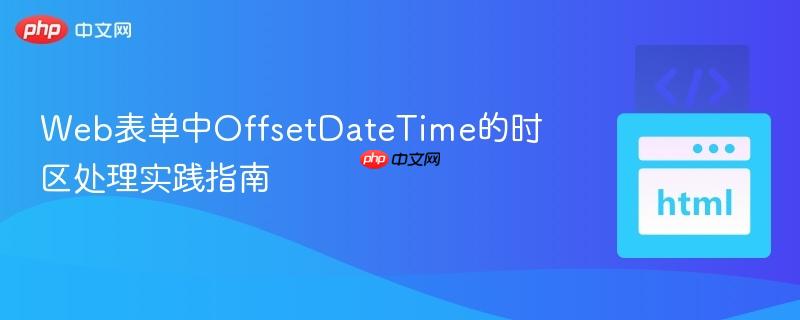
java.time.offsetdatetime代表了一个带有相对于格林威治/utc的固定偏移量的日期和时间,它精确地定义了时间轴上的一个特定瞬间。在web应用中,当用户通过表单输入一个事件的日期和时间(例如,使用<input type="datetime-local"/>)时,他们通常输入的是其本地时区下的日期和时间。然而,datetime-local这类html控件并不会将用户的时区偏移信息一并提交到服务器。
这就引发了一个核心问题:如果服务器在没有明确时区信息的情况下,将用户输入的本地日期时间直接解析为OffsetDateTime,那么这个时间点将被错误地解释为服务器所在时区的某个时刻。例如,一个在美国的用户输入了“10月27日14:30”,如果服务器在中国,则系统可能会将其误解为“中国时间10月27日14:30”,而不是用户期望的“美国时间10月27日14:30”。这种模糊性对于需要精确时间点的事件(如会议、航班、预约等)是不可接受的。
一些开发者可能会考虑尝试从浏览器获取用户的当前时区。然而,这种方法存在局限性。用户的当前时区(例如,通过JavaScript Intl.DateTimeFormat().resolvedOptions().timeZone 获取)可能与事件实际发生的时区不一致。例如,一位德国商务人士目前在日本东京参加会议,但她正在预订一个将在美国芝加哥举行的活动。此时,无论是她的居住地时区(德国),还是她当前所在位置的时区(日本),都不能准确代表事件发生的时区(美国芝加哥)。因此,仅仅依赖浏览器的时区信息并不能解决问题。
为了确保OffsetDateTime的准确性,最可靠的方法是明确地要求用户提供事件发生所在的时区。这不仅消除了歧义,也确保了业务逻辑与用户的真实意图相符。
时区名称通常采用Continent/Region(大陆/区域)的格式,例如Europe/Paris(欧洲/巴黎)或Africa/Tunis(非洲/突尼斯)。这种命名方式清晰且具有层级结构,非常适合在用户界面中设计一个友好的时区选择器。
在后端,一旦我们从用户界面获取了本地日期时间以及明确指定的时区名称,就可以利用java.time API来构建准确的OffsetDateTime对象。
首先,根据用户选择的大陆和区域信息,构建完整的时区名称字符串,并使用ZoneId.of()方法获取对应的ZoneId对象。
import java.time.ZoneId;
import java.time.DateTimeException;
public class TimeZoneParser {
public static ZoneId parseUserSelectedZone(String userSelectedContinent, String userSelectedRegion) {
if (userSelectedContinent == null || userSelectedRegion == null || userSelectedContinent.isEmpty() || userSelectedRegion.isEmpty()) {
throw new IllegalArgumentException("大陆和区域信息不能为空。");
}
String zoneName = String.join("/", userSelectedContinent, userSelectedRegion);
ZoneId zoneId = null;
try {
zoneId = ZoneId.of(zoneName);
System.out.println("成功解析时区: " + zoneId);
} catch (DateTimeException e) {
// ZoneRulesException 是 DateTimeException 的子类,用于处理无效的时区规则
System.err.println("无效的时区名称或规则: " + zoneName + " - " + e.getMessage());
// 根据实际需求,可以选择抛出自定义异常或返回默认值
throw new IllegalArgumentException("用户选择的时区无效: " + zoneName, e);
}
return zoneId;
}
public static void main(String[] args) {
// 示例用法
ZoneId parisZone = parseUserSelectedZone("Europe", "Paris");
// ZoneId invalidZone = parseUserSelectedZone("InvalidContinent", "InvalidRegion"); // 会抛出异常
}
}接下来,将用户输入的本地日期(LocalDate)和本地时间(LocalTime)组合成一个LocalDateTime,然后结合上一步获取的ZoneId,最终转换为OffsetDateTime。
import java.time.LocalDate;
import java.time.LocalTime;
import java.time.LocalDateTime;
import java.time.ZoneId;
import java.time.ZonedDateTime;
import java.time.OffsetDateTime;
public class EventTimeConverter {
public static OffsetDateTime convertToOffsetDateTime(LocalDate localDate, LocalTime localTime, ZoneId zoneId) {
// 1. 组合本地日期和时间
LocalDateTime localDateTime = LocalDateTime.of(localDate, localTime);
System.out.println("用户输入的本地日期时间: " + localDateTime);
// 2. 使用ZoneId创建ZonedDateTime
// localDateTime.atZone(zoneId) 会将 localDateTime 解释为在 zoneId 时区下的时间点
ZonedDateTime zonedDateTime = localDateTime.atZone(zoneId);
System.out.println("对应的ZonedDateTime: " + zonedDateTime);
// 3. 转换为OffsetDateTime
// toOffsetDateTime() 会根据 ZonedDateTime 的时区规则计算出偏移量
OffsetDateTime offsetDateTime = zonedDateTime.toOffsetDateTime();
System.out.println("最终的OffsetDateTime: " + offsetDateTime);
return offsetDateTime;
}
public static void main(String[] args) {
// 假设从用户界面获取了这些值
LocalDate userDate = LocalDate.of(2023, 10, 27); // 用户输入的日期
LocalTime userTime = LocalTime.of(14, 30); // 用户输入的时间
ZoneId userSelectedZone = TimeZoneParser.parseUserSelectedZone("America", "Chicago"); // 用户选择的时区
OffsetDateTime eventOffsetDateTime = convertToOffsetDateTime(userDate, userTime, userSelectedZone);
// 进一步处理,例如存储到数据库
// System.out.println("存储到数据库的OffsetDateTime: " + eventOffsetDateTime);
}
}通过上述步骤,我们就能确保从Web表单获取的日期时间被正确地解析为一个精确的OffsetDateTime,从而避免了因时区模糊性导致的时间点错误。
从Web表单中获取OffsetDateTime并正确处理时区是一个常见的挑战。仅仅依赖HTML表单控件或浏览器的默认时区信息是不可靠的。核心解决方案在于明确地引导用户选择事件发生的时区,并结合java.time API将用户输入的本地日期时间与指定时区组合起来,从而构建出精确无误的OffsetDateTime对象。通过遵循本文提供的实践指南,开发者可以有效避免因时区问题导致的时间点错误,确保应用程序的健壮性和准确性。
以上就是Web表单中OffsetDateTime的时区处理实践指南的详细内容,更多请关注php中文网其它相关文章!

每个人都需要一台速度更快、更稳定的 PC。随着时间的推移,垃圾文件、旧注册表数据和不必要的后台进程会占用资源并降低性能。幸运的是,许多工具可以让 Windows 保持平稳运行。




Copyright 2014-2025 https://www.php.cn/ All Rights Reserved | php.cn | 湘ICP备2023035733号